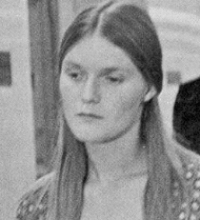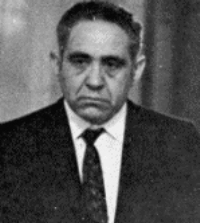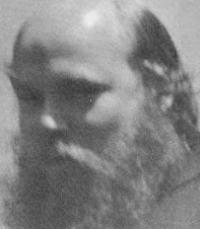Linda Kasabian, Star Witness for the Prosecution

Linda Kasabian grew up in broken home with a stepfather she strongly disliked. At age 16, she left her mother's home in New Hampshire and headed west "looking," she said, "for God." Instead, she found lots of drugs, lots of sex, and--on July 4, 1969--Charles Manson. Married, mother of a two-year-old girl and pregnant at the time, Kasabian learned from a friend about "this beautiful man named Charlie" and the idyllic life his followers led at Spahn Ranch. To Kasabian, it was the "answer to an unspoken prayer."
Soon after arriving at Spahn, Kasabian made love to Manson. She said later that she thought Manson "could see inside her." She soon fell in love with the man who would send her on a mission of death.
Kasabian had only been a member of the Family for six weeks when Manson announced, on August 8, 1969, "Now is the time for Helter Skelter." Kasabian joined Tex Watson, Susan Atkins, and Patricia Krenwinkel in traveling to the Tate home, where she witnessed the shooting of Steven Parent and the vicious attacks on Abigail Folger and Voytek Frykowsi. Kasabian did not directly participate in the murders, later telling Manson, "I'm not you, Charlie--I can't kill anybody." The next night Kasabian rode with Manson and other Family members to the LaBianca home, but did not enter the home or see either of the murders.
Three days after the LaBianca murders, Kasabian slipped out of Spahn Ranch in a borrowed car and headed for Taos, New Mexico, where she rejoined her husband. After returning to California to retrieve her child, Tanya, Kasabian hitchhiked first to Florida and then to her mother's home in New Hampshire.
California authorities issued a warrant for Kasabian's arrest on December 1, 1969. Kasabian voluntarily surrendered to police in Concord, New Hampshire and was flown back to California. She wanted to tell her story.
Almost immediately, her attorney, Gary Fleishman, proposed to prosecutors a deal whereby Kasabian would testify against other Family members in return for complete immunity. Having previously made a deal with Susan Atkins, Prosecutor Vince Bugliosi initially rejected the proposal. When Atkins changed her mind and announced she would not testify at the trial, Bugliosi quickly negotiated a deal with Kasabian's attorney: the prosecution would petition for immunity after she testified. Kasabian turned out to be a great witness--brutally frank and very believable. She left the stand after eighteen days of testimony. In his closing argument, Bugliosi said Charles Manson "sent out from the fires of hell at Spahn Ranch three heartless, bloodthirsty robots and--unfortunately for him--one human being, the hippie girl Linda Kasabian."
After completing her testimony, Kasabian rejoined he husband and children, moving into a small farm in New Hampshire. She moved to the Pacific Northwest for awhile, living under an assumed name. Later, she left her husband and returned to New Hampshire, where she lived a rough, rather down-and-out life in the 1980s.
Vincent Bugliosi, Chief Prosecutor

Vincent Bugliosi, chief prosecutor in the Tate-LaBianca murder trials, was born in the northern Minnesota town of Hibbing (also the childhood home of musician Bob Dylan and basketball star Kevin McHale). His family moved to southern California, where Bugliosi graduated from Hollywood High School before attending Miami University on a tennis scholarship.
After graduating from UCLA Law School in 1964, Bugliosi took a job in the office of the Los Angeles District Attorney. Bugliosi quickly developed a strong reputation, winning convictions in 103 of 104 felony jury trials. On November 18, 1969, Bugliosi learned that he had been given his greatest responsibility to date: trying the Tate-LaBianca murder case.
Bugliosi threw himself into the case, working 100-hour weeks for the almost two years between assignment and sentencing. Unlike many prosecutors, Bugliosi became very involved in the investigation, accompanying detectives on searches of Spahn and Barker ranches, checking on leads, and interviewing key witnesses.
Bugliosi's chief goal in the Tate-LaBianca case was securing a first-degree murder conviction of Charles Manson. He identified the key to the case as proving that Manson had total dominion over other Family members. With the important testimony of Linda Kasabian and others, he was successful in doing so.
During the course of the trial, Charles Manson told the bailiff, "I am going to have Bugliosi and the judge killed." Knowing Manson's record, officials did not take this to be an idle threat and a bodyguard was assigned to accompany Bugliosi during the remainder of the trial. Bugliosi received numerous hang-up calls during the middle of the night (even when he changed to an unlisted number), but no attempts were made on his life. After Manson's sentencing, Bugliosi had, at Manson's request, a ninety-minute conversation with Manson, in which the convicted killer told him, "I don't have hard feelings" and that he did "a fantastic" job in convicting him.
After the Manson trials, Bugliosi took to almost full-time writing. His book about the Manson trial, Helter Skelter, was published in 1974. Other subjects of his writing include the war on drugs, the Kennedy assassination, and a 1996 book on the O. J. Simpson trial, Outrage: The Five Reasons Why O. J. Simpson Got Away With Murder.
Two of his most recent books are No Island of Sanity: Paula Jones v Bill Clinton (1998) and The Betrayal of America (2001), a book criticizing the Supreme Court decision handing the presidency to George W. Bush.
Irving Kanarek, Attorney for Charles Manson

Even before his remarkable performance as the defense attorney for Charles Manson in the Tate-LaBianca murder case, Irving Kanarek earned a reputation as an obstructionist of the first order. He was frequently censured by judges. One judge bluntly called him "the most obstructionist man I have ever met." Kanarek has a purpose for his obstructionism tactics: his goal seemed to be to confuse juries and knock opposing attorneys off stride, especially in cases where the evidence against his client was overwhelming.
In March 1970, Ronald Hughes--Manson's first attorney--suggested to Manson that Kanarek enter the case as his attorney. Although calling Karerek "the worst man in town I could pick," Manson requested that Kanarek be substituted as his attorney two weeks before the start of trial. Prosecutor Vince Bugliosi strongly objected to the substitution of Kanarek as Manson's attorney, but Judge Older found no legal ground for denying Manson's request and Kanarek.
Kanarek may have established some sort of record for objections in the Manson trial. He objected nine times during the prosecution's opening statement, and by the third day of trial had registered more than 200 objections when the press stopped counting. Frequently, Kanarek's objection were made in "shotgun" form, including many suggested grounds that were totally inapplicable: "Leading and suggestive; no foundation; conclusion and hearsay." Other times his objections were intended to influence the jury. For example, he objected to the testimony of Linda Kasabian by declaring, "Object, Your Honor, on the grounds this witness is not competent because she is insane!" Kanarek also bombarded the court with motions, many of them novel to say the least, such as a motion to have "Mr. Manson suppressed from evidence" as the product of an illegal search. Kanarek raised eyebrows for asking bizarre questions, such as when he asked Kasabian (during his seven-day cross-examination after Kasabian's direct testimony in which she revealed she had taken LSD about fifty times), "Describe what happened on trip number twenty-three."
Kanarek was found guilty of contempt four times during the Manson trial. The first contempt came when Judge Older found Kanarek guilty of "directly violating my order not to repeatedly interrupt." On two occasions, Kanarek was ordered to overnight in the county jail. Near the end of the long trial, Older told Kanarek he was "totally without scruples, ethics, and professional responsibility."
Despite his aggressive representation, Kanarek's work did not always please his client. At one point, Manson was ready to dismiss Kanarek when the defense attorney begged on his knees to keep him. Manson reportedly also threatened at various times to have Kanarek killed.
In his seven-day summation--which Judge Older called not an "argument but a filibuster"--, Kanarek argued that the female defendants killed their victims not for Manson, but out of love for Tex Watson.
Despite the press's view of Kanarek as something of a joke, Prosecutor Vince Bugliosi had a different opinion. Bugliosi wrote in his book Helter Skelter that Kanarek "frequently scored points."
Kanarek was ordered to be inactive by the California State Bar in 1990.
Ronald Hughes, Murdered Attorney for Van Houten

Prior to his representation of Leslie Van Houten in the Tate-LaBianca murder trial, Ronald Hughes had never tried his case. His inexperience showed frequently early on in the trial, but by the trial's midpoint, Prosecutor Vince Bugliosi though he was doing "damn well." Hughes, called "the hippie lawyer" by some, had an intimate knowledge of the hippie subculture that sometimes served his client well. For example, he was able to raise questions about Linda Kasabian's credibility by asking her about hallucinogenic drugs, her belief in ESP, her thoughts that she might be a witch, and her experiencing "vibrations" from Charles Manson.
Hughes was among the first lawyers to meet with Charles Manson in December, 1969. Initially signed on as the attorney for Charles Manson, Hughes was replaced by Irving Kanarek two weeks before the start of the trial.
As attorney for defendant Leslie Van Houten, Hughes tried to separate the interests of his client from those of Charles Manson. He hoped to show that Van Houten was not acting independently, but was completely controlled in her actions by Manson.
Hughes decision to pursue an independent strategy almost certainly cost him his life. On the last weekend of November, 1970, Hughes disappeared while camping in a remote area near Sespe Hot Springs. His badly decomposed body was not discovered until four months later. Although no one was ever charged with the murder of Hughes, at least two Family members have admitted that the killing of Hughes was a "retaliation murder" by Manson.
After Hughes disappeared, police searched the garage behind a friend's house that was Hughes's home. In the dirty garage, police saw the mattress Hughes used as his bed and his framed bar certificate on the wall, but no clues that might explain what happened to him.
